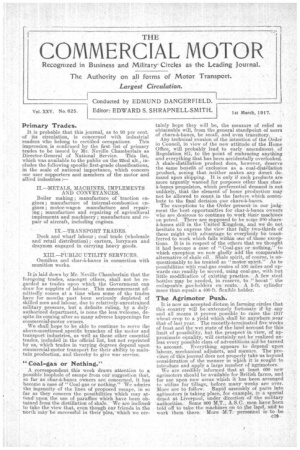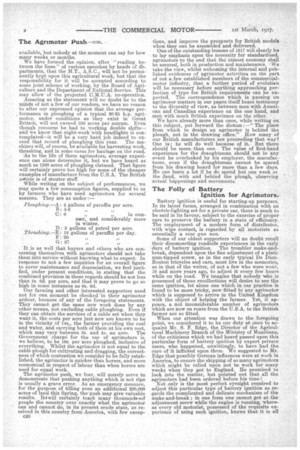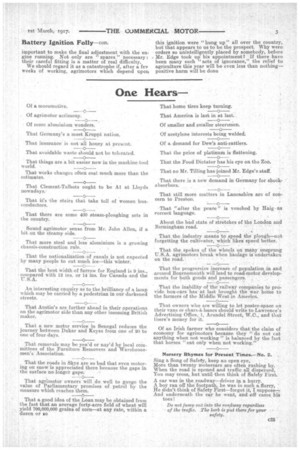Primary Trades.
Page 1

Page 2

Page 3

If you've noticed an error in this article please click here to report it so we can fix it.
It is probable that this journal, as to 90 per cent. of its circulation, is concerned with industrial readers who belong to certified occupations. This impression is confirmed by the first list of primary trades to be issued by Mr. Neville Chamberlain as Director-General of National Service. This list, which was available to the public on the 22nd ult., includes the following speoific,first-grade classifications, in the scale of national importance, which concern our user supporters and members of the motor and allied industries :—
IL—METALS, MACHINES, IMPLEMENTS AND CONVEYANCES. Boiler making ; manufacture of traction engines; manufacture of internal-combustion ensines; motor-wagon manufacture and repairing; manufacture and repairing of agricultural
• implements and machinery; manufacture and repair of aircraft, including engines.
IX.--TRANSPORT TRADES.
Dock and wharf labour ; coal trade (wholesale and retail distribution); • carters, lorrymen and drayrnen engaged in carrying heavy goods.
XIII.—PUBLIC UTILITY SERVICES. Omnibus and char-k-banes in connection with munition works.
It j.s laid down by Mr. Neville Chamberlain that the foregoing trades, amongst others, shall not be regarded as trades upon which the Government can draw for supplies of labour. This announcement admittedly, comes at a time when some of the trades have for months past been seriously depleted of skilled men and labour, due to relatively-unrestrained military pressure, but a definite ruling, by a dulyauthorized department, is none the less welcome, despite its eonaing after so many adverse happenings for commercial-motor owners.
We shall hope to be able to continue to serve the above-mentioned specific branches of the motor and transport industries, as well as those other essential trades, Included in the official list, but not reprinted by us, which trades in varying degrees depend upon commercial-motor transport for their ability to maintain production, and thereby to give war service.
"Coal-gas or Nothing."
A correspondent this week draws attention to a. possible loophole of escape from our suggestion that, so far as char-h-bancs owners are concerned, it has become a case of "Coal-gas or nothing." We admire the ingenuity of the lines of proposed escape, in so far as they concern the possibilities which may attend upon the use of paraffins which have been obtained from the distillation of shale. We are inclined, to take the view that, even though Our friends in the north'inay be successful in their plea, which we eer
thinly hope they will be, the measure of relief so obtainable will from the general standpoint of users of chars-it-banes, be small, and even transitory.
Any technical evasion of the intention of the Order in Council, in view of the neW attitude of the Home Office, will probably lead to early amendment of Regulation 8G, to the point of embracing anything and everything that has been accidentally overlooked. A shale-distillation product does, however, deserve the same benefit of exclusion as a coal-distillation product, seeing that ,neither makes any direct demand upon Shipping. It is only if such products are more urgently wanted for purposes other than char'à-banes propulsion, which preferential demand is not unlikely, that the element of home production may not be allowed to count, in the faaters,whicth contribute to the final decision elm chars:A-banes. The •exceptions to the Order-present in our judgment the best opportunities for char-a-bancs owners who are desirous to continue to work their machines on petrol. There are Supposed to be some 900 charsa-bancs still in the United' Kingdom, aud, we do not hesitate to express the view that 'fully twoethirds of these might with advantage to everybody be transferred to work which falls within one of those exceptions. It is in respect of the others that we thought it had 'become a case of "Coal-gas or nothing," to which exception we now gladly add.the comparable alternative of shale oil. Shale spirit, of course, is unquestien.ably to be treated as `.` motor spirit." As to possibilities with coal-gas routes of 100 miles 'and upwards can readily be served, using coal-gas, with but little modifieation of existing-practice. A,few steel bottles-may be needed, in reserve, to ".boost ' the coilapsable gas-holders en route. A 5-ft. cylinder more than equalii a 400-ft. flexible holder.
• ,
The Agrimotor Push.
• It is now an accepted dictum in farming circles that this .country will be -extreniely fortunate if by any and all' means it proves possible to raise the 1917 wheat crop to a yield which' shall be anywhere. near that of last year. • The recently-terminated five Weeks of frost and the wet state of the land account for thislimit of possibility; but the prospect in view, of approximate equality, will certainly not be realized unless every possible class of adventitious aid be turned to account. Everything appears to depend' upon labour, mechanical adjuncts, and mamire. The province of this journa,rdoes not properly take us beyond consideration of the manner in which it is sought to introduee and apply a large number of agrimotors. We are credibly informed that at least 600 new agriniotors should be available for British farms, and for use upon new areas which it has been arranged to utilize for tillage, before many weeks are over. More are to f6Ilow. Rapid assembly of parts into agrimotors is taking place, for example, in a special depot at. Liverpool, 'under direction of -the military 'authorities. Some 600 KT., A.S.C. men have been 'told off to take the machines no to the land, and to work them there. More M.T. personnel is to be
available, but nobody at the moment can say for how many weeks or months.
We have formed the opinion, after " reading between the lines" of various speeches by heads of Apartments, that the M.T., A.S.C., will not be permanently kept upon this agricultural work, but that the responsibility for it will be accepted according to some joint scheme of working, by the Board of Agriculture and the Department of National Service. This may allow of the projected C.M.U:A. co-operation. Amazing as the statement will no doubt be to the minds of not a few of our readers, we have no reason to alter our expressed opinion that the average performance in ploughing of a typical 20-25 h.p. agrimotor, under conditions as they exist in Great Britain, will not exceed 350 acres per annum. Even though recourse be had to working double skiftsand we know that night-work with headlights is contemplated—it will be a very hard job indeed to exceed that record of ploughing this year. The machines will, of course, be available for harvesting work, thrashing, and in some cases for haulage on the road. As to the life of these agrimotors, average experience can alone determine it, but we have heard as much as 1500 acres of ploughing claimed. That figure will certainly prove too high for some of the cheaper examples of manufacture from the U.S.A. The British article is of stouter stuff.
While writing on the subject of performances, we may quote a few consumption figures, supplied to us by farmers who have used agrimotors for several seasons. They are as under :— Ploughing.—A: 4 gallons of paraffin per acre. B: 5-6 7) C 6vderain summer, and considerably more
in winter.
D: 3 gallons of petrol per acre. .Thrashing.—E : 12 gallons of paraffin per day. F : 20
/7 71
• G : 27 • It is as well that buyers and others who are concerning themselves with agrimotors should not take them into service without knowing what to expect. In response to not a few inquiries for an overall figure to cover maintenance and depreciation, we feel justified, under present conditions, in stating that the combined provision in these regards should be not less than 4s. 6d. per acre, and that it may prove to go so high in some instances as as. 6d.
Our farming and other interested supporters need not for one, moment be checked -in their agrimotor ardour, because of any• of the foregoing statements. They cannot get the same new work clone by any other means, not excluding cable ploughing. Even if they can obtain the services of a cable set when they want it, the costs per acre just now are known to be in the vicinity of 14s., the farmer providing the coal and water, and carrying both of them at his own cost, which may vary-between 3s. and 4s. an acre. The Government charge: for the use of agrimotors is. we believe, to be 16s. per acre ploughed, inclusive of everything. Whilst the agrimotor is not equal to the cable plough for cultivating and dragging, the correctness of which contention we consider to be fully established, the agrimotor is quicker than horses, and more economidal in respect of labour than when horses are used for equal work.
The agrimotor push, we fear, will merely serve to demonstrate that pushing anything which is not ripe is usually a grave error. , As an emergency measure, for the purpose of tilling even an additional 200,004 wires of land this Spring, the push may give valuable results. It' will certainly teach many thousands aof people the country over exactly what' the agrimotor can and cannot do, in its present crude state, as received in this country from America, with few excep 020 tions, and improve the prospects for British models when they can be assembled and delivered. One of the outstanding lessons of 1917 will clearly be to lay emphasis upon the necessity for standardised. agrimotors to the end that the utmost economy shall be assured, both in production and maintenance. -We take the view, whilst welcoming the internal and published evidences of agrimotor activities on the part of not a few established members of the commercialmotor industry, that a further period of evolution will, be necessary before anything approaching perfection of type for British requirements can be expected. The correspondence which is passing on agrimotor matters in our pages itself bears testimony to the diversity of view, as between men with Amen.can and Canadian experience on the one hand, and men with much British experience on the other.
We have already more than once, while writing on this subject, put forward the dictum.: The place from which to design an agrimotor is laehind the plough, not in the drawing office." How many of our British manufacturers are proceeding that way? One is; he will do well because of it. But there should be more, than one. The value of first-hand experience for the draughtsman should not in any event be overlooked by his employer, the manufacturer, even if the draughtsman cannot be spared from his drawing board for more than a few days. He can learn a lot if he do spend but one week or the !land, with and behind the plough, observing actual happenings and movements.
The Folly of • Battery Ignition for Agrimotors.
Battery ignition is useful for starting-up purposes. In its latest forms, arranged in combination with an electric-lighting set for a private car, there is much to be said in its favour, subject to the exercise of proper care to preserve the battery in a state of efficiency. The employment of a modern form of distributor, with wipe contact, is regarded by all motorists as essentially a sine qua non.
Some of our oldest supporters will no doubt recall their disconcerting roadside experiences in the early days of battery ignition. The trembler make-andbreak, dependent upon the fine adjustment of a platinum-tipped screw, as in the early typical De Dion-. Bouton tricycles and cars, must live in the memories, as in that of the writer, of not a few who were wont, 18 and more years ago, to adjust it every few hours while on the road. We imagine that nobody who is possessed of those recollections will desire to see the same ignition, let alone one which in car practice is found to be more tricky, now fitted to any agrimotor which is supposed to arrive in the United Kingdom with the object of helping the farmer. Yet, it appears, a not inconsiderable number of agrimotors which are now en route from the U.S.A. to the British farmer are so fitted.
When our attention was drawn to the foregoing point, we considered it to be our duty at once to acquaint Mr. S. F. Edge, the Director of the Agricultural Machinery Branch of the Ministry of Munitions, of the criticisms which we had heard passed upon this particular form of battery ignition by expert private users, who happened, unwittingly, to have had the care of it inflicted upon them. We suggested to Mr. Edge that possibly German influences were at work in America, to ensure the shipping of so many agrimotors which might be relied upon not to work for many weeks when they got to England. He promised to look into the matter, but pointed out that all -the agrimotors had been ordered before his time I Not only is the most perfect eyesight required to adjust this particular type of battery ignition as regards the complicated and delicate mechanism of the make-and-break ; in one form one cannot get at the adjustment screw while the engine is running, whereas every old motorist, possessed of the requisite experience of using such ignition, knows that it is all
important to make the final adjustment with the engine running. Not only are " spares " necessary : their careful fitting is a matter of real difficulty.
We should regard it as a catastrophe if, after a fey weeks of working, agrimotors which depend upou
this ignition were "hung up" all over the country, but that appears to us to be the prospect. Why were orders so unintelligently placed by somebody, before Mr. Edge took uphis appointment? If there have
, been many such acts of ignorance," the relief to agriculture this year will be even less than nothing— positive harm will be done




















